Evaluating Locational Preference of Urban Activities with the Time-Dependent Accessibility Using Integrated Spatial Economic Models
Abstract
:1. Introduction
2. Literature Review
2.1. Overview of Accessibility Measures
2.2. Modeling Techniques for Location Preferences and Interactions of Urban Activities
3. Study Data and Methodology
3.1. Study Area
3.2. Study Data
3.2.1. Household Travel Survey (HTS) Data
3.2.2. Transport Networks
3.2.3. Land Use Data
3.3. Methodology
3.3.1. Transport Model
- = utility-based accessibility measure
- = transport utility (disutility) from origin i to destination j during time t
- = transport coefficients (these represent the sensitivity of commuters to mode and trip type)
- = opportunities at destination zone j (in the case of households, jobs are considered as the opportunities, while in the case of commercial services, the residential population is considered as the opportunity).
3.3.2. Integrated Spatial Economic Model (ISE) Models
- (i)
- Economic and demographic module: this module consists of economic and demographic information about the study area;
- (ii)
- Activity allocation module: the AA module of the ISE model uses nested and additive logit theory, which was adopted to test the research hypothesis of this study. The AA module is an aggregate representation of activities, commodity flows, markets with aggregate demands and supplies, and exchange prices. It concerns the quantities of activities, commodity flows, aggregate demands, and supply and exchange prices;
- (iii)
- Space development module: the space module represents real-estate developer behavior. This module develops the space based on the exchange price signal from the AA module;
- (iv)
- Transport module: the transport model was developed to calculate TDA to various activity locations for 2012 and 2015.
- -
- Morning peak: 7 a.m.–9 a.m.;
- -
- Off-peak: 10 a.m.–1 p.m.;
- -
- Evening peak: 4 p.m.–7 p.m.
3.3.3. Simulating Activity Location Choices with the ISE Model
- —
- d = buying (consuming) or selling (producing) the commodity
- —
- k = index for the zone of production or consumption of the commodity
- —
- z = index for an exchange zone
- —
- = dispersion parameter for the exchange location choice for the commodity
- —
- = accessibility for a commodity for direction d and zone k
- —
- = an indicator of the relative amount of the commodity offered in exchange zone z
- —
- = transport cost coefficient
- —
- = transport cost between z and k for d = buying and selling, T = time of the day
- —
- = price coefficient (always set to 1 for d = selling and −1 for d = buying because the utility is in monetary units)
- —
- Price z = price of a commodity in z
- —
- Ln = natural log
- (i)
- Transport component (cost of transporting commodities to or from the exchange zone);
- (ii)
- Price (prices of commodities in the exchange zone);
- (iii)
- Size (relative size of the exchange zone).
4. Results
4.1. Numerical Analysis
- —
- Locational preferences of household activities;
- —
- Locational preferences of commercial services (household obtained services such as retail).
4.1.1. Locational Preferences of Household Activities
4.1.2. Locational Preferences of Commercial Activities
5. Discussion
- —
- Household activity location model;
- —
- Commercial services activity location model.
6. Conclusions and Recommendations
6.1. Conclusions
6.2. Limitations and Recommendations
Author Contributions
Funding
Institutional Review Board Statement
Informed Consent Statement
Data Availability Statement
Acknowledgments
Conflicts of Interest
References
- Marwal, A.; Silva, E. Literature review of accessibility measures and models used in land use and transportation planning in last 5 years. J. Geogr. Sci. 2022, 32, 560–584. [Google Scholar] [CrossRef]
- Farrington, J.H. The new narrative of accessibility: Its potential contribution to discourses in (transport) geography. J. Transp. Geogr. 2007, 15, 319–330. [Google Scholar] [CrossRef]
- Salih, S.H.; Lee, J.B. Measuring transit accessibility: A dispersion factor to recognise the spatial distribution of accessible opportunities. J. Transp. Geogr. 2022, 98, 103238. [Google Scholar] [CrossRef]
- Srinivasan, S.; Ferreira, J. Travel behavior at the household level: Understanding linkages with residential choice. Transp. Res. Part D Transp. Environ. 2002, 7, 225–242. [Google Scholar] [CrossRef]
- Raza, A.; Zhong, M. Evaluating Public Transit Equity with the Concept of Dynamic Accessibility. In Proceedings of the 2019 5th International Conference on Transportation Information and Safety (ICTIS), Liverpool, UK, 14–17 July 2019; pp. 1463–1468. [Google Scholar]
- Lee, Y.; Washington, S.; Frank, L.D. Examination of relationships between urban form, household activities, and time allocation in the Atlanta Metropolitan Region. Transp. Res. Part A Policy Pract. 2009, 43, 360–373. [Google Scholar] [CrossRef]
- van Heerden, Q.; Karsten, C.; Holloway, J.; Petzer, E.; Burger, P.; Mans, G. Accessibility, affordability, and equity in long-term spatial planning: Perspectives from a developing country. Transp. Policy 2022, 120, 104–119. [Google Scholar] [CrossRef]
- Baraklianos, I.; Bouzouina, L.; Bonnel, P. The impact of accessibility on the location choices of the business services. Evidence from Lyon urban area. Reg. Dev. 2018, 48, 85–104. [Google Scholar]
- Litman, T. Evaluating Public Transit Benefits and Costs; Victoria Transport Policy Institute: Victoria, BC, Canada, 2015. [Google Scholar]
- Waddell, P. UrbanSim: Modeling urban development for land use, transportation, and environmental planning. J. Am. Plan. Assoc. 2002, 68, 297–314. [Google Scholar] [CrossRef]
- Ahuja, R.; Tiwari, G. Evolving term “accessibility” in spatial systems: Contextual evaluation of indicators. Transp. Policy 2021, 113, 4–11. [Google Scholar] [CrossRef]
- Mao, L.; Nekorchuk, D. Measuring spatial accessibility to healthcare for populations with multiple transportation modes. Health Place 2013, 24, 115–122. [Google Scholar] [CrossRef]
- Litman, T. Developing indicators for comprehensive and sustainable transport planning. Transp. Res. Rec. 2007, 2017, 10–15. [Google Scholar] [CrossRef] [Green Version]
- Bhat, C.R.; Paleti, R.; Singh, P. A spatial multivariate count model for firm location decisions. J. Reg. Sci. 2014, 54, 462–502. [Google Scholar] [CrossRef]
- El-Geneidy, A.; Buliung, R.; Diab, E.; van Lierop, D.; Langlois, M.; Legrain, A. Non-stop equity: Assessing daily intersections between transit accessibility and social disparity across the Greater Toronto and Hamilton Area (GTHA). Environ. Plan. B Plan. Des. 2016, 43, 540–560. [Google Scholar] [CrossRef]
- Widener, M.J.; Farber, S.; Neutens, T.; Horner, M. Spatiotemporal accessibility to supermarkets using public transit: An interaction potential approach in Cincinnati, Ohio. J. Transp. Geogr. 2015, 42, 72–83. [Google Scholar] [CrossRef] [Green Version]
- Kujala, R.; Weckström, C.; Mladenović, M.N.; Saramäki, J. Travel times and transfers in public transport: Comprehensive accessibility analysis based on Pareto-optimal journeys. Comput. Environ. Urban Syst. 2018, 67, 41–54. [Google Scholar] [CrossRef]
- Lee, J.; Miller, H.J. Measuring the impacts of new public transit services on space-time accessibility: An analysis of transit system redesign and new bus rapid transit in Columbus, Ohio, USA. Appl. Geogr. 2018, 93, 47–63. [Google Scholar] [CrossRef]
- Safdar, M.; Jamal, A.; Al-Ahmadi, H.M.; Rahman, M.T.; Almoshaogeh, M. Analysis of the Influential Factors towards Adoption of Car-Sharing: A Case Study of a Megacity in a Developing Country. Sustainability 2022, 14, 2778. [Google Scholar] [CrossRef]
- Wang, Z.; Safdar, M.; Zhong, S.; Liu, J.; Xiao, F. Public Preferences of Shared Autonomous Vehicles in Developing Countries: A Cross-National Study of Pakistan and China. J. Adv. Transp. 2021, 2021, 5141798. [Google Scholar] [CrossRef]
- Ali Aden, W.; Zheng, J.; Ullah, I.; Safdar, M. Public Preferences Towards Car Sharing Service: The Case of Djibouti. Front. J. Environ. Sci. 2022, 10, 889453. [Google Scholar] [CrossRef]
- Mishra, S.; Ye, X.; Ducca, F.; Knaap, G.-J. A functional integrated land use-transportation model for analyzing transportation impacts in the Maryland-Washington, DC Region. Sustain. Sci. Pract. Policy 2011, 7, 60–69. [Google Scholar] [CrossRef]
- Moeckel, R.; Garcia, C.L.; Chou, A.T.M.; Okrah, M.B. Trends in integrated land-use/transport modeling. J. Transp. Land Use 2018, 11, 463–476. [Google Scholar] [CrossRef]
- Echenique, M.H.; Flowerdew, A.D.; Hunt, J.D.; Mayo, T.R.; Skidmore, I.J.; Simmonds, D.C. The MEPLAN models of bilbao, leeds and dortmund. Transp. Rev. 1990, 10, 309–322. [Google Scholar] [CrossRef]
- Acheampong, R.A.; Silva, E.A. Land use–transport interaction modeling: A review of the literature and future research directions. J. Transp. Land Use 2015, 8, 11–38. [Google Scholar] [CrossRef]
- Hunt, J.; Abraham, J. Design and implementation of pecas: A generalised system for allocating economic production, exchange and consumption quantities. In Integrated Land-Use and Transportation Models; Emerald Group Publishing Limited: Bingley, UK, 2005; pp. 253–273. [Google Scholar]
- Wang, W.; Zhong, M.; Hunt, J.D. Analysis of the Wider Economic Impact of a Transport Infrastructure Project Using an Integrated Land Use Transport Model. Sustainability 2019, 11, 364. [Google Scholar] [CrossRef] [Green Version]
- Hunt, J.D.; Kriger, D.S.; Miller, E.J. Current operational urban land-use–transport modelling frameworks: A review. Transp. Rev. 2005, 25, 329–376. [Google Scholar] [CrossRef]
- Bertolini, L.; Clercq, F.; Kapoen, L. Sustainable accessibility: A conceptual framework to integrate transport and land use plan-making. Two test-applications in the Netherlands and a reflection on the way forward. Transp. Policy 2005, 12, 207–220. [Google Scholar] [CrossRef]
- Järv, O.; Tenkanen, H.; Salonen, M.; Ahas, R.; Toivonen, T. Dynamic cities: Location-based accessibility modelling as a function of time. Appl. Geogr. 2018, 95, 101–110. [Google Scholar] [CrossRef]
- Fransen, K.; Neutens, T.; Farber, S.; De Maeyer, P.; Deruyter, G.; Witlox, F. Identifying public transport gaps using time-dependent accessibility levels. J. Transp. Geogr. 2015, 48, 176–187. [Google Scholar] [CrossRef] [Green Version]
- Bastiaanssen, J.; Johnson, D.; Lucas, K. Does better job accessibility help people gain employment? The role of public transport in Great Britain. Urban Stud. 2022, 59, 301–322. [Google Scholar] [CrossRef]
- Guo, Y.; Peeta, S. Impacts of personalized accessibility information on residential location choice and travel behavior. Travel Behav. Soc. 2020, 19, 99–111. [Google Scholar] [CrossRef]
- Lei, T.L.; Church, R.L. Mapping transit-based access: Integrating GIS, routes and schedules. Int. J. Geogr. Inf. Sci. 2010, 24, 283–304. [Google Scholar] [CrossRef]
- Zhang, Y.; Li, W.; Deng, H.; Li, Y. Evaluation of Public Transport-Based Accessibility to Health Facilities considering Spatial Heterogeneity. J. Adv. Transp. 2020, 2020, 7645153. [Google Scholar] [CrossRef] [Green Version]
- Rahman, M.H.; Ashik, F.R.; Mouli, M.J. Investigating spatial accessibility to urban facility outcome of transit-oriented development in Dhaka. Transp. Res. Interdiscip. Perspect. 2022, 14, 100607. [Google Scholar] [CrossRef]
- Almansoub, Y.; Zhong, M.; Raza, A.; Safdar, M.; Dahou, A.; Al-qaness, M.A. Exploring the Effects of Transportation Supply on Mixed Land-Use at the Parcel Level. Land 2022, 11, 797. [Google Scholar] [CrossRef]
- Bivina, G.R.; Gupta, A.; Parida, M. Influence of microscale environmental factors on perceived walk accessibility to metro stations. Transp. Res. Part D Transp. Environ. 2019, 67, 142–155. [Google Scholar] [CrossRef]
- Vandenbulcke, G.; Steenberghen, T.; Thomas, I. Mapping accessibility in Belgium: A tool for land-use and transport planning? J. Transp. Geogr. 2009, 17, 39–53. [Google Scholar] [CrossRef]
- Benenson, I.; Martens, K.; Rofé, Y.; Kwartler, A. Public transport versus private car GIS-based estimation of accessibility applied to the Tel Aviv metropolitan area. Ann. Reg. Sci. 2011, 47, 499–515. [Google Scholar] [CrossRef] [Green Version]
- Miller, H.J. Place-based versus people-based accessibility. In Access to Destinations; Emerald Group Publishing Limited: Bingley, UK, 2005. [Google Scholar]
- Foth, N.; Manaugh, K.; El-Geneidy, A.M. Towards equitable transit: Examining transit accessibility and social need in Toronto, Canada. J. Transp. Geogr. 2013, 29, 1–10. [Google Scholar] [CrossRef]
- Van Wee, B. Accessible accessibility research challenges. J. Transp. Geogr. 2016, 51, 9–16. [Google Scholar] [CrossRef] [Green Version]
- Handy, S.L.; Niemeier, D.A. Measuring accessibility: An exploration of issues and alternatives. Environ. Plan. A 1997, 29, 1175–1194. [Google Scholar] [CrossRef]
- Geurs, K.T.; Van Wee, B. Accessibility evaluation of land-use and transport strategies: Review and research directions. J. Transp. Geogr. 2004, 12, 127–140. [Google Scholar] [CrossRef]
- Ilägcrstrand, T. What about people in regional science? In Proceedings of the 9th European Congress of the Regional Science Association, Brighton, UK, 27–30 May 1970. [Google Scholar]
- Lowry, I.S. A Model of Metropolis; Rand Corp Santa Monica Calif: Santa Monica, CA, USA, 1964. [Google Scholar]
- Hoyt, H. Economic background of cities. J. Land Public Util. Econ. 1941, 17, 188–195. [Google Scholar] [CrossRef]
- Foot, D. Operational Urban Models: An Introduction; Routledge: Milton Park, UK, 2017. [Google Scholar]
- Garin, R.A. Research note: A matrix formulation of the Lowry model for intrametropolitan activity allocation. J. Am. Inst. Plan. 1966, 32, 361–364. [Google Scholar] [CrossRef]
- Hill, D.M. A Growth Allocation Model for the Eoston Region. J. Am. Inst. Plan. 1965, 31, 111–120. [Google Scholar] [CrossRef]
- Brotchie, J.F.; Dickey, J.W.; Sharpe, R. TOPAZ: General Planning Technique and Its Applications at the Regional, Urban, and Facility Planning Levels; Springer Science & Business Media: Berlin/Heidelberg, Germany, 2013; Volume 180. [Google Scholar]
- Anas, A. Modeling in Urban and Regional Economics to Appear as a Volume in Fundamentals of Pure and Applied Economics; Harwood Academic Publishers: Reading, UK, 1988. [Google Scholar]
- Alonso, W. Location and land use. In Location and Land Use; Harvard University Press: Cambridge, MA, USA, 2013. [Google Scholar]
- Herbert, J.D.; Stevens, B.H. A model for the distribution of residential activity in urban areas. J. Reg. Sci. 1960, 2, 21–36. [Google Scholar] [CrossRef]
- Ingram, G.K.; Kain, J.F.; Ginn, J.R. Front matter, the Detroit prototype of the NBER urban simulation model. In The Detroit Prototype of the NBER Urban Simulation Model; NBER: Cambridge, MA, USA, 1972; pp. 20–28. [Google Scholar]
- Southworth, F. A Technical Review of Urban Land Use—Transportation Models as Tools for Evaluating Vehicle Travel Reduction Strategies; Research and Innovation Technology Administrator: Washington, DC, USA, 1995. [Google Scholar]
- Timmermans, H.J. The saga of integrated land use-transport modeling: How many more dreams before we wake up? In Proceedings of the International Association of Traveler Behavior Conference, Lucerne, Switzerland, 10–15 August 2003. [Google Scholar]
- Wegener, M. Overview of land use transport models. In Handbook of Transport Geography and Spatial Systems; Emerald Group Publishing Limited: Bingley, UK, 2004. [Google Scholar]
- Iacono, M.; Levinson, D.; El-Geneidy, A. Models of transportation and land use change: A guide to the territory. J. Plan. Lit. 2008, 22, 323–340. [Google Scholar] [CrossRef]
- Thomas, I.; Jones, J.; Caruso, G.; Gerber, P. City delineation in European applications of LUTI models: Review and tests. Transp. Rev. 2018, 38, 6–32. [Google Scholar] [CrossRef]
- Anderstig, C.; Mattsson, L.-G. Modelling land-use and transport interaction: Policy analyses using the IMREL model. In Network Infrastructure and the Urban Environment; Springer: Berlin/Heidelberg, Germany, 1998; pp. 308–328. [Google Scholar]
- Hensher, D.A.; Ton, T. TRESIS: A transportation, land use and environmental strategy impact simulator for urban areas. Transp. 2002, 29, 439–457. [Google Scholar] [CrossRef]
- Wieland, F.; Tyagi, A.; Kumar, V.; Krueger, W. Metrosim: A metroplex-wide route planning and airport scheduling tool. In Proceedings of the 14th AIAA Aviation Technology, Integration, and Operations Conference, Atlanta, GA, USA, 16–20 June 2014; p. 2162. [Google Scholar]
- Martinez, F. MUSSA: Land use model for Santiago city. Transp. Res. Rec. 1996, 1552, 126–134. [Google Scholar] [CrossRef]
- Zhong, M.; Yu, B.; Liu, S.; Hunt, J.D.; Wang, H. A method for estimating localised space-use pattern and its applications in integrated land-use transport modelling. Urban Stud. 2018, 55, 3708–3724. [Google Scholar] [CrossRef]
- Wegener, M. Land-use transport interaction models. In Handbook of Regional Science; Springer: Berlin/Heidelberg, Germany, 2021; pp. 229–246. [Google Scholar]
- Zhong, M.; Wang, W.; Hunt, J.D.; Pan, P.H.; Chen, T.; Li, J.; Yang, W.; Zhang, K. Solutions to cultural, organizational, and technical challenges in developing PECAS models for the cities of Shanghai, Wuhan, and Guangzhou. J. Transp. Land Use 2018, 11, 1193–1229. [Google Scholar] [CrossRef]
- Chen, B.Y.; Yuan, H.; Li, Q.; Wang, D.; Shaw, S.-L.; Chen, H.-P.; Lam, W.H. Measuring place-based accessibility under travel time uncertainty. Int. J. Geogr. Inf. Sci. 2017, 31, 783–804. [Google Scholar] [CrossRef]
- Lucas, K.; van Wee, B.; Maat, K. A method to evaluate equitable accessibility: Combining ethical theories and accessibility-based approaches. Transportation 2016, 43, 473–490. [Google Scholar] [CrossRef] [Green Version]
- Tenkanen, H.; Saarsalmi, P.; Järv, O.; Salonen, M.; Toivonen, T. Health research needs more comprehensive accessibility measures: Integrating time and transport modes from open data. Int. J. Health Geogr. 2016, 15, 1–12. [Google Scholar] [CrossRef] [PubMed] [Green Version]
- Widener, M.J.; Minaker, L.; Farber, S.; Allen, J.; Vitali, B.; Coleman, P.C.; Cook, B. How do changes in the daily food and transportation environments affect grocery store accessibility? Appl. Geogr. 2017, 83, 46–62. [Google Scholar] [CrossRef]
- Greene, D.L.; Wegener, M. Sustainable transport. J. Transp. Geogr. 1997, 5, 177–190. [Google Scholar] [CrossRef]
- Miller, H.J. Time geography. In Handbook of Behavioral and Cognitive Geography; Edward Elgar Publishing: Cheltenham, UK, 2018. [Google Scholar]
- de Jong, G.; Daly, A.; Pieters, M.; van der Hoorn, T. The logsum as an evaluation measure: Review of the literature and new results. Transp. Res. Part A Policy Pract. 2007, 41, 874–889. [Google Scholar] [CrossRef] [Green Version]
- Huang, B.; Wu, B.; Barry, M. Geographically and temporally weighted regression for modeling spatio-temporal variation in house prices. Int. J. Geogr. Inf. Sci. 2010, 24, 383–401. [Google Scholar] [CrossRef]
- Jäppinen, S.; Toivonen, T.; Salonen, M. Modelling the potential effect of shared bicycles on public transport travel times in Greater Helsinki: An open data approach. Appl. Geogr. 2013, 43, 13–24. [Google Scholar] [CrossRef]
- Xiao, Z.; Mao, B.; Xu, Q.; Chen, Y.; Wei, R. Reliability of Accessibility: An Interpreted Approach to Understanding Time-Varying Transit Accessibility. J. Adv. Transp. 2022, 2022, 9380884. [Google Scholar] [CrossRef]
- Moya-Gómez, B.; Salas-Olmedo, M.H.; García-Palomares, J.C.; Gutiérrez, J. Dynamic accessibility using big data: The role of the changing conditions of network congestion and destination attractiveness. Netw. Spat. Econ. 2018, 18, 273–290. [Google Scholar] [CrossRef]
- Siewwuttanagul, S.; Inohae, T. Spatio-temporal Retail Competition Factors Accessibility in Hakata Station, Japan. In Proceedings of the Urban Rail Transit, Singapore, 5 February 2021; pp. 167–184. [Google Scholar]
- Li, S.; Duan, H.; Smith, T.E.; Hu, H. Time-varying accessibility to senior centers by public transit in Philadelphia. Transp. Res. Part A Policy Pract. 2021, 151, 245–258. [Google Scholar] [CrossRef]
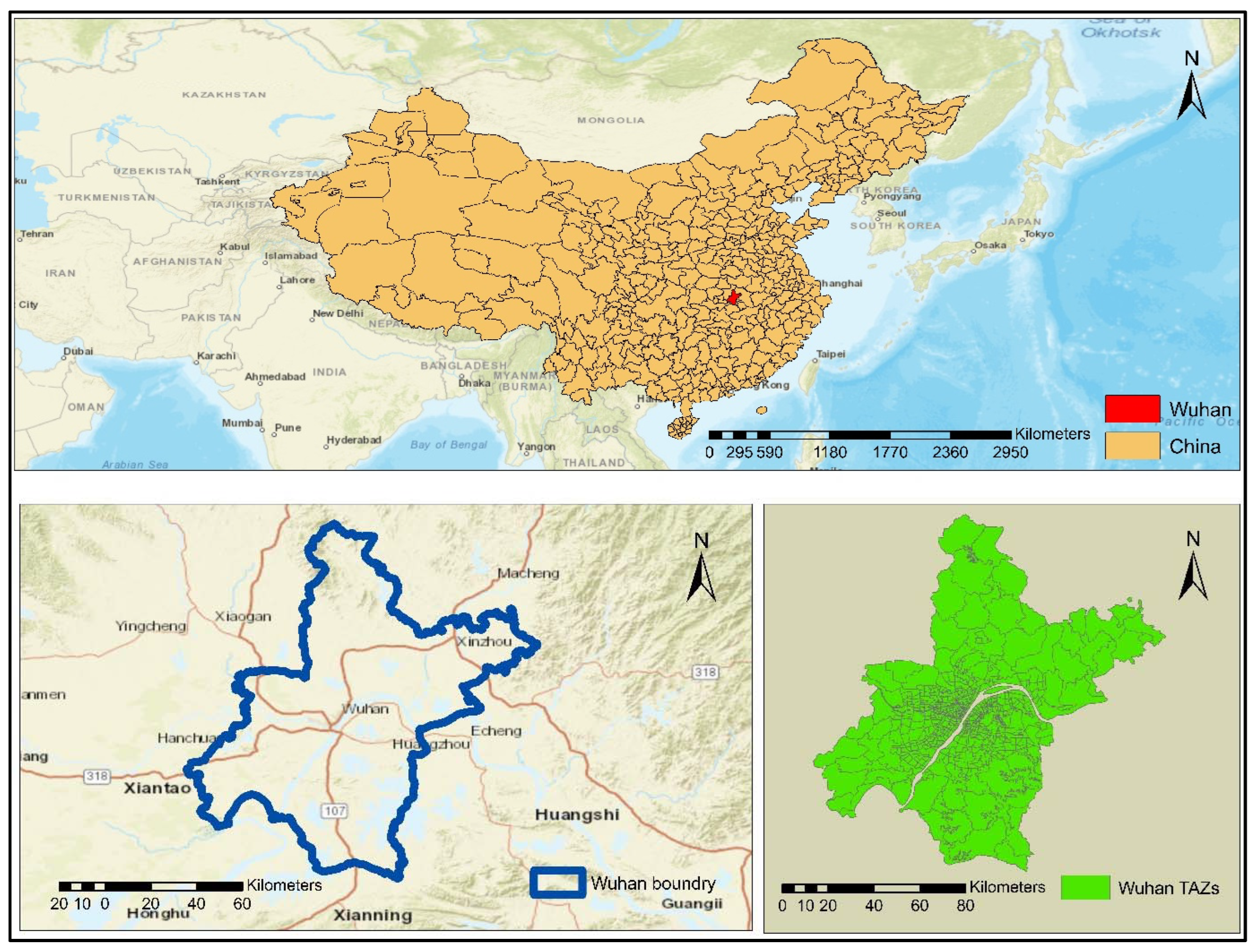
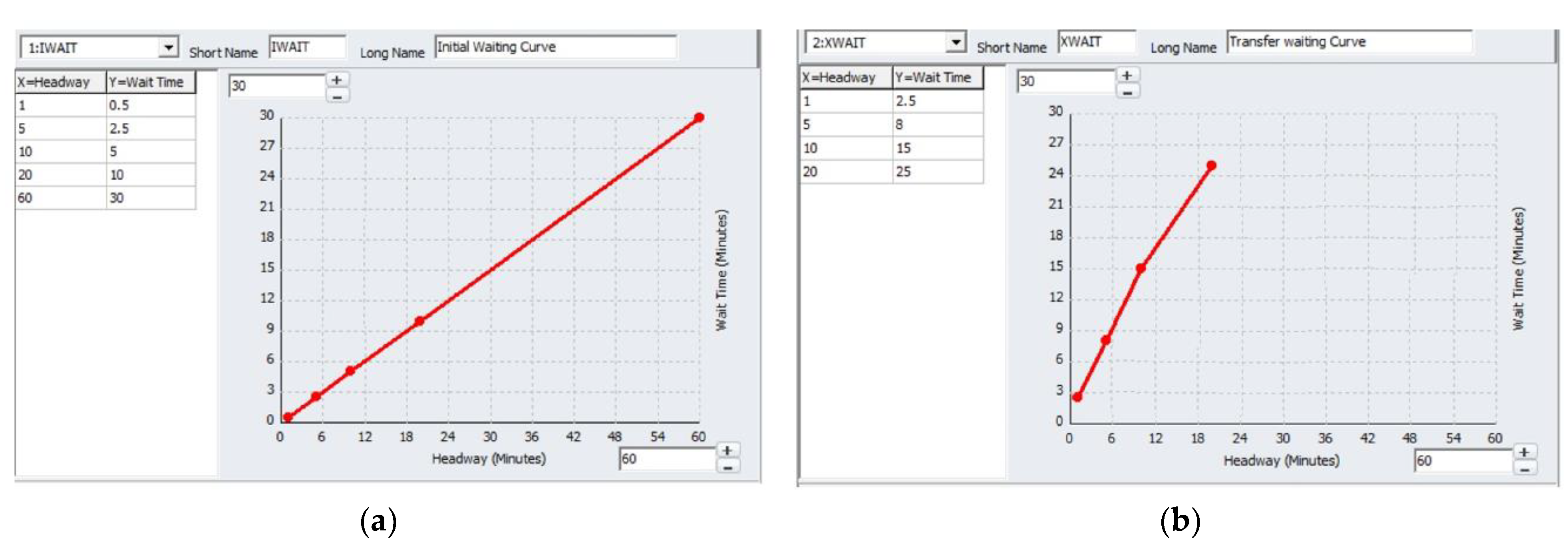
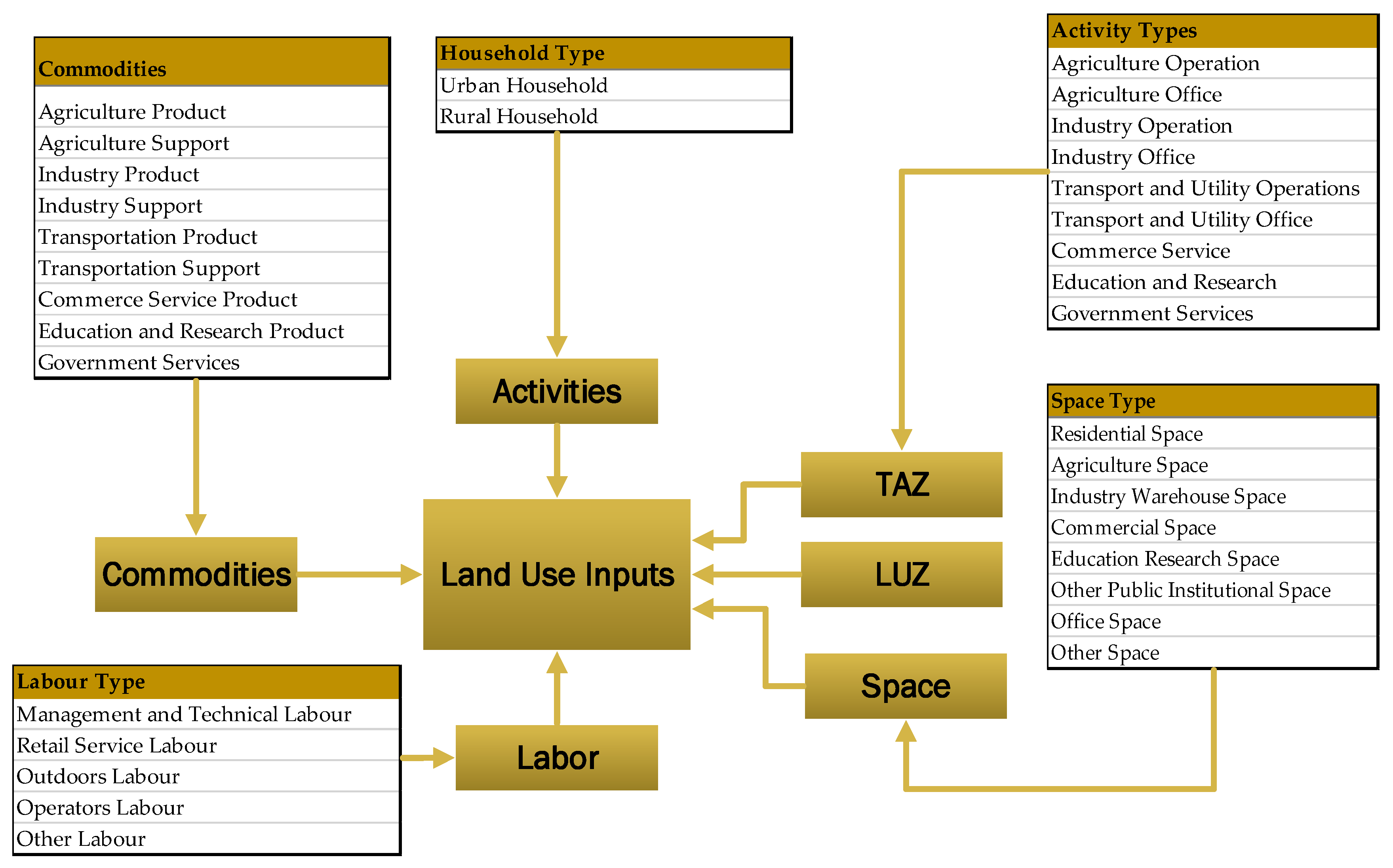
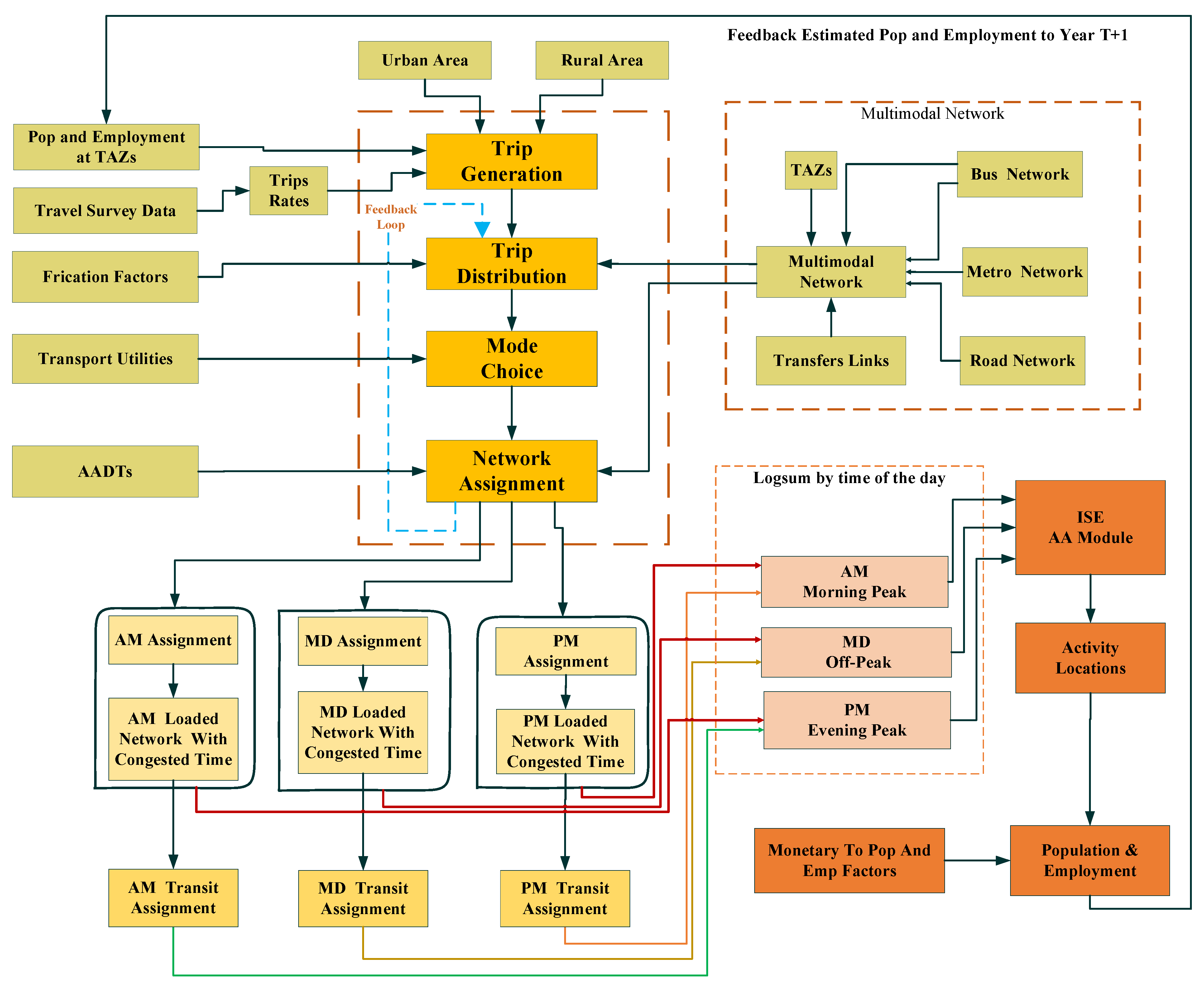

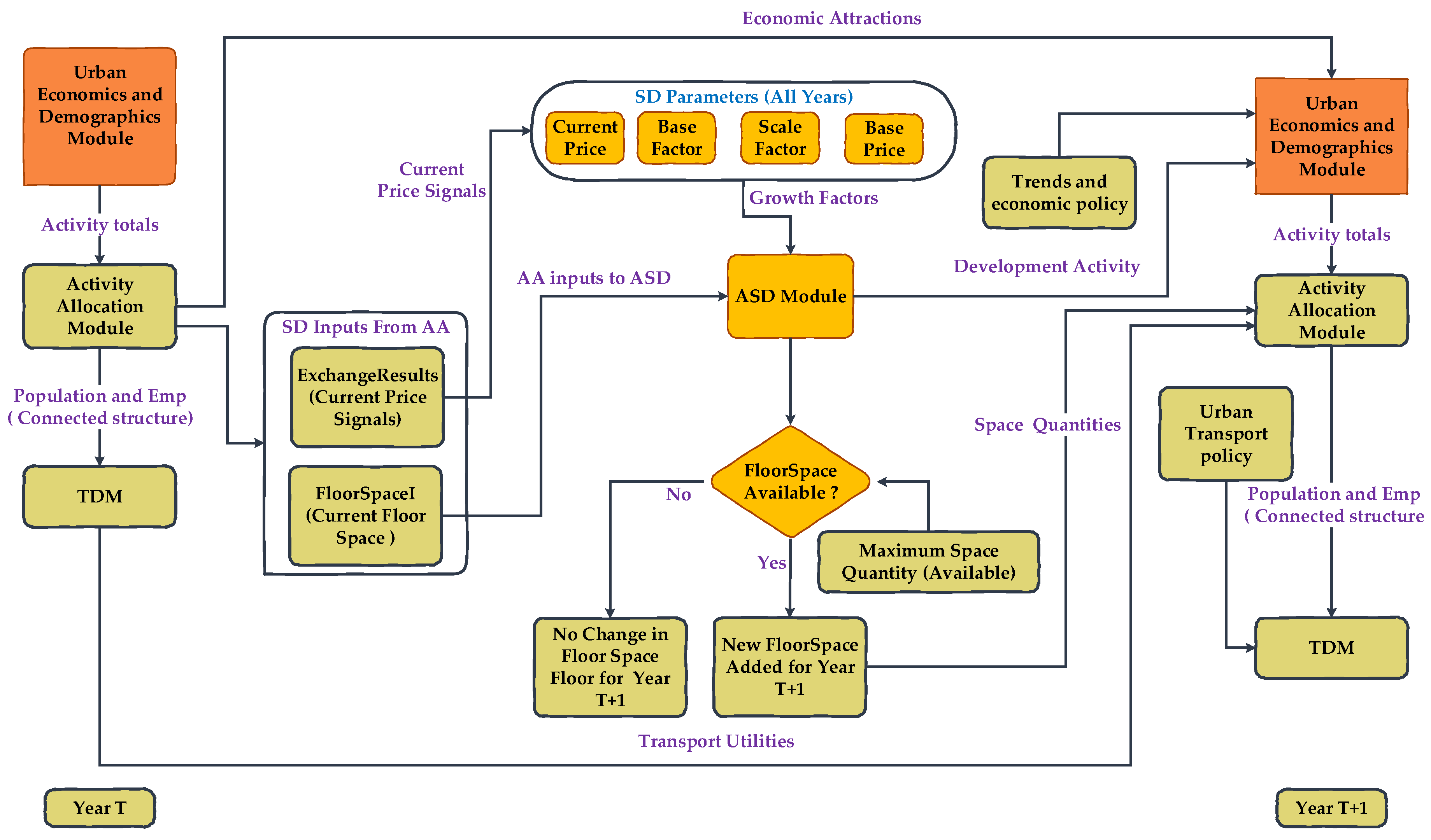
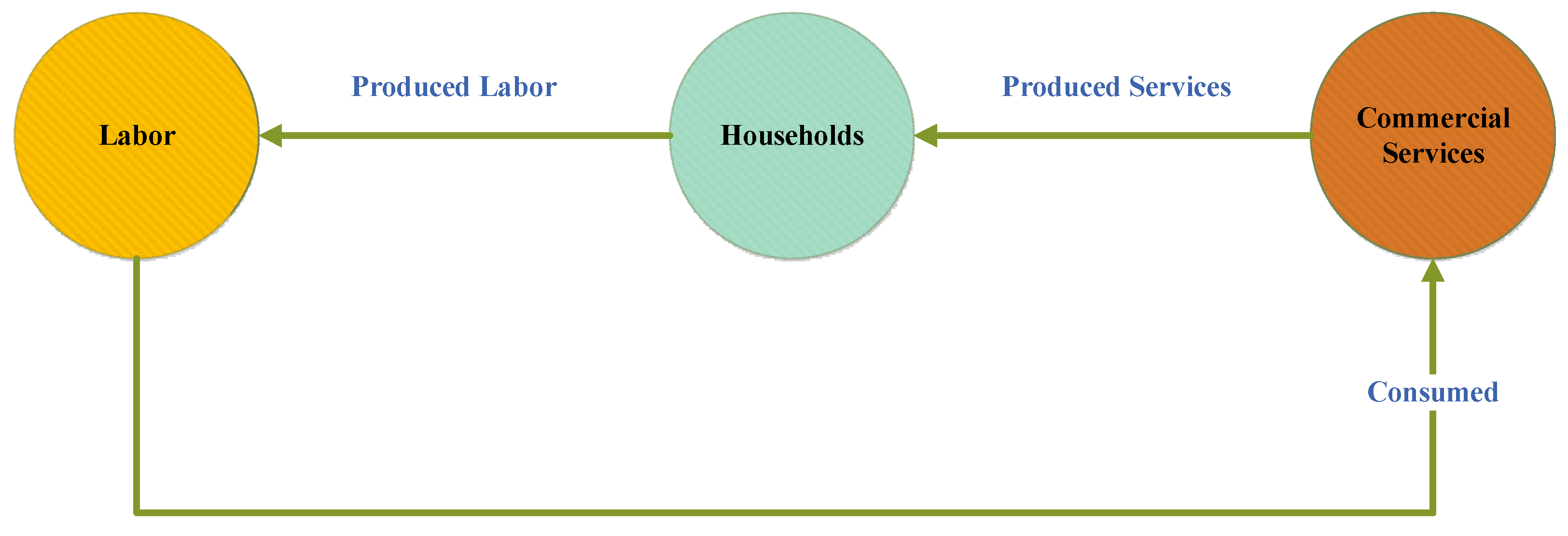
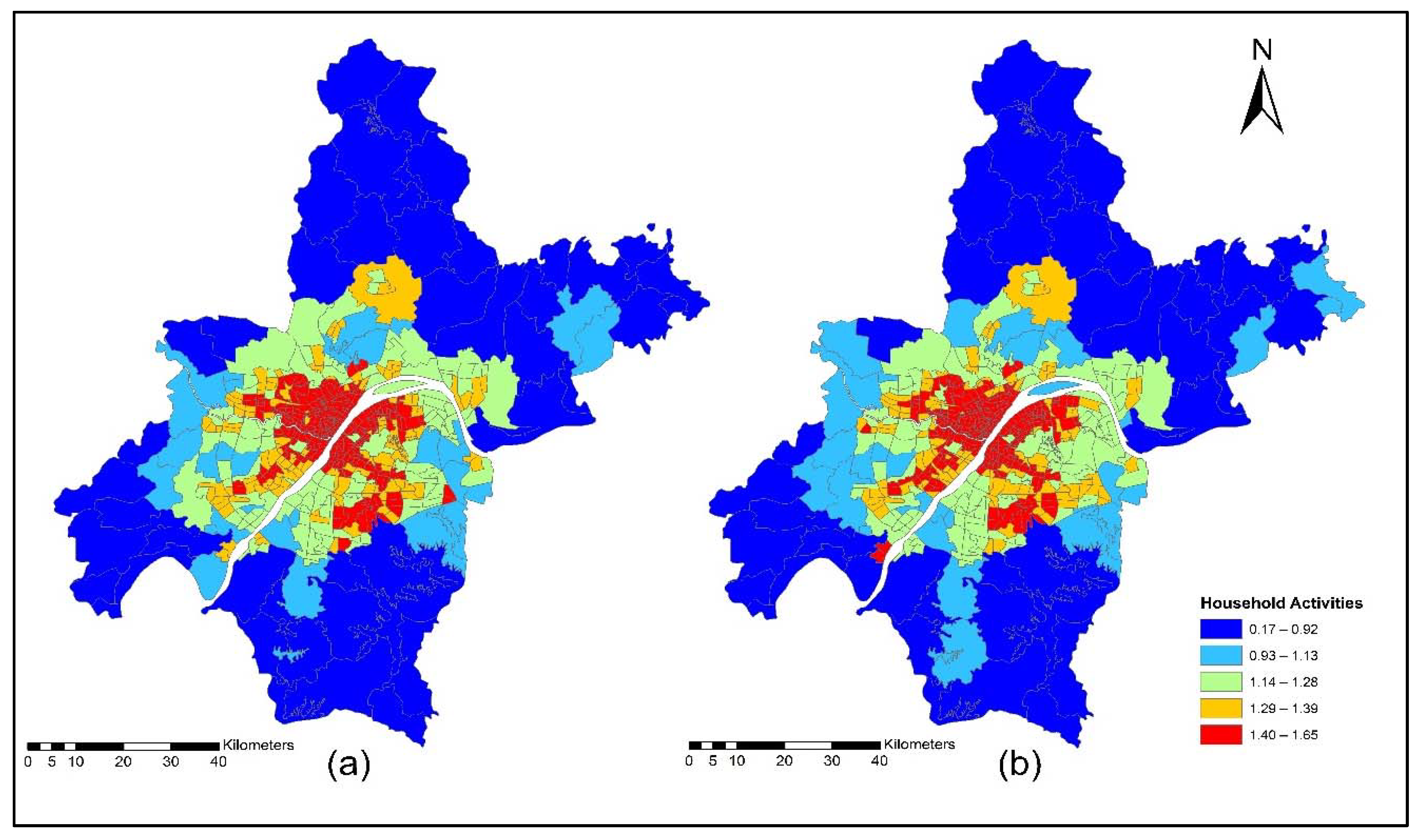
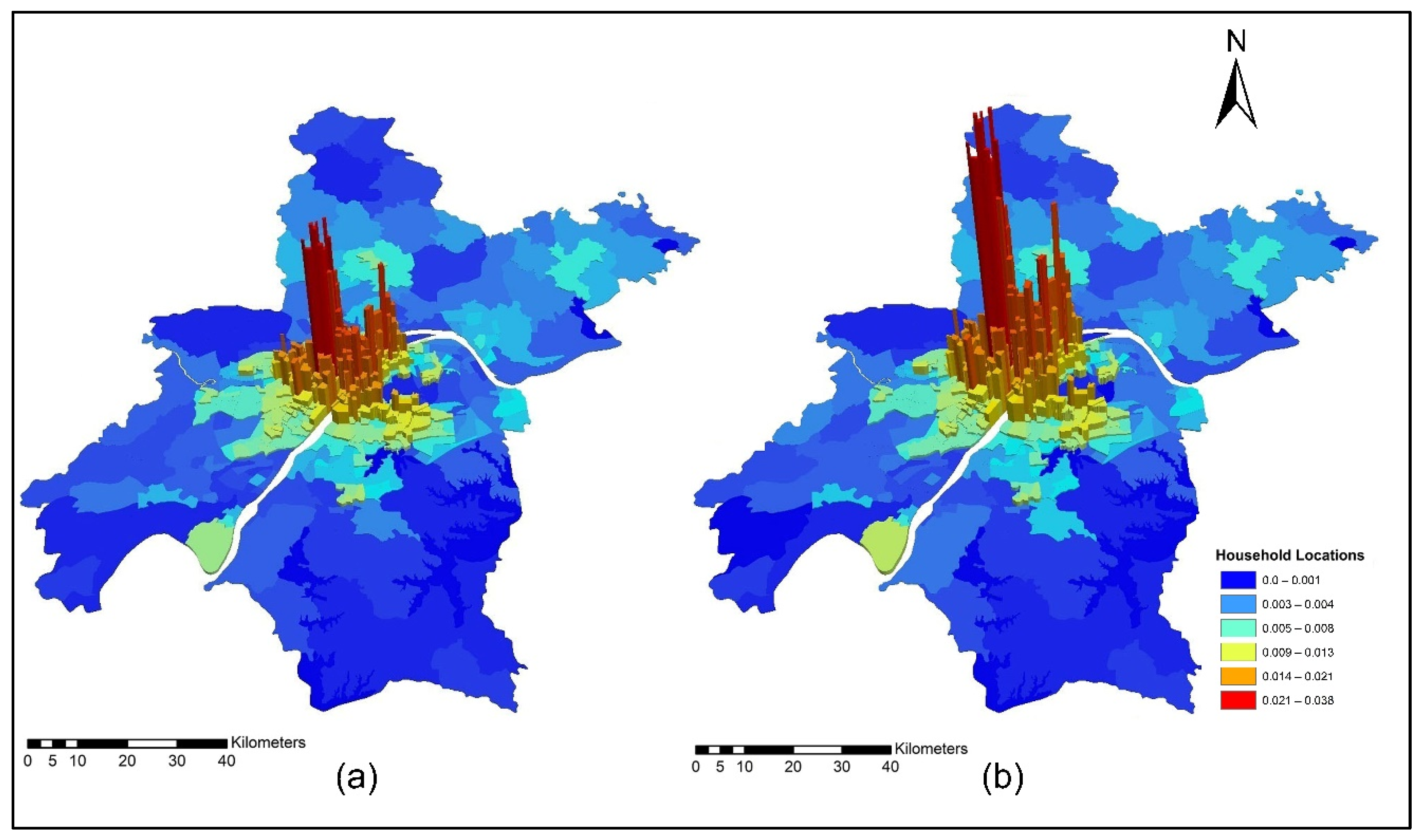

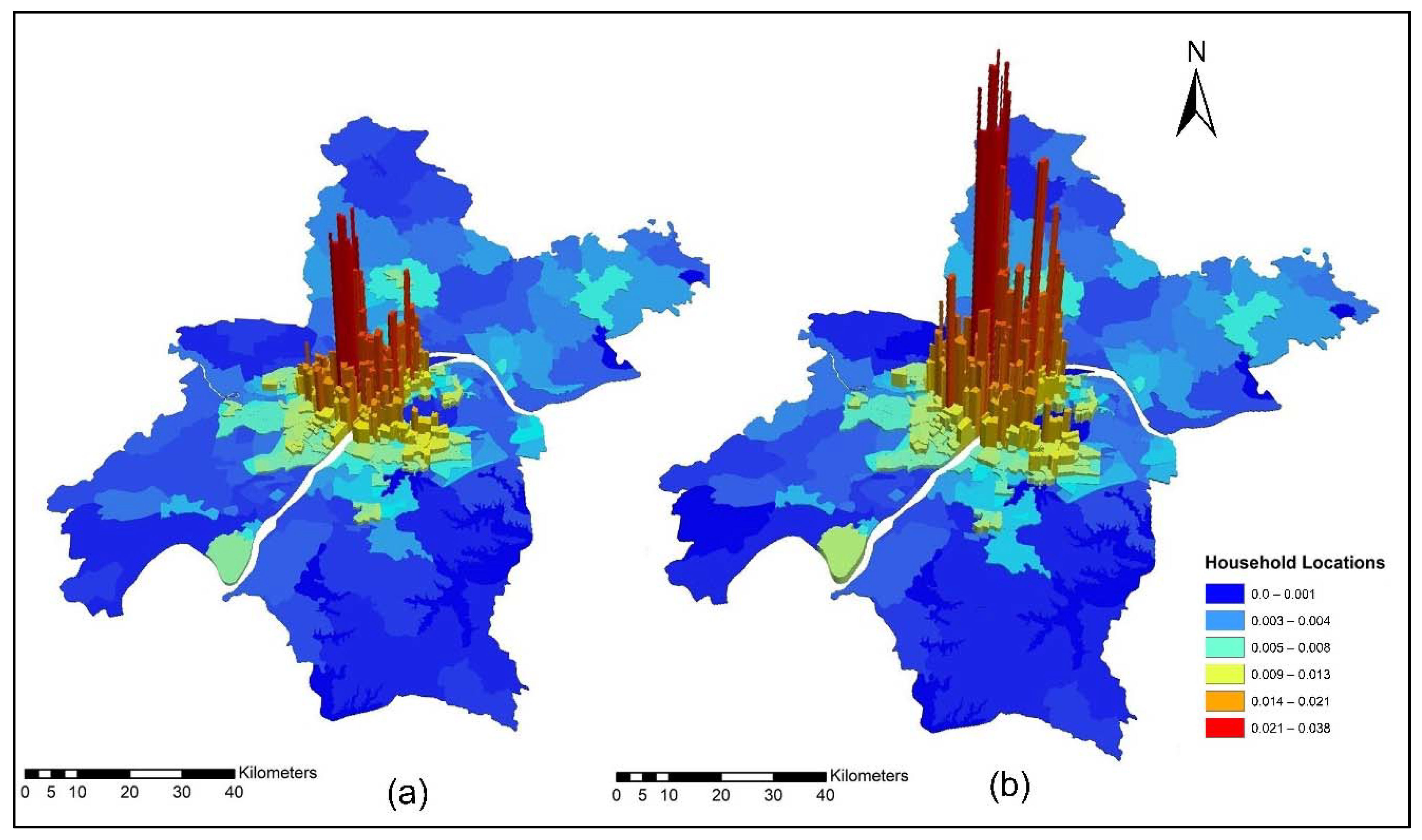
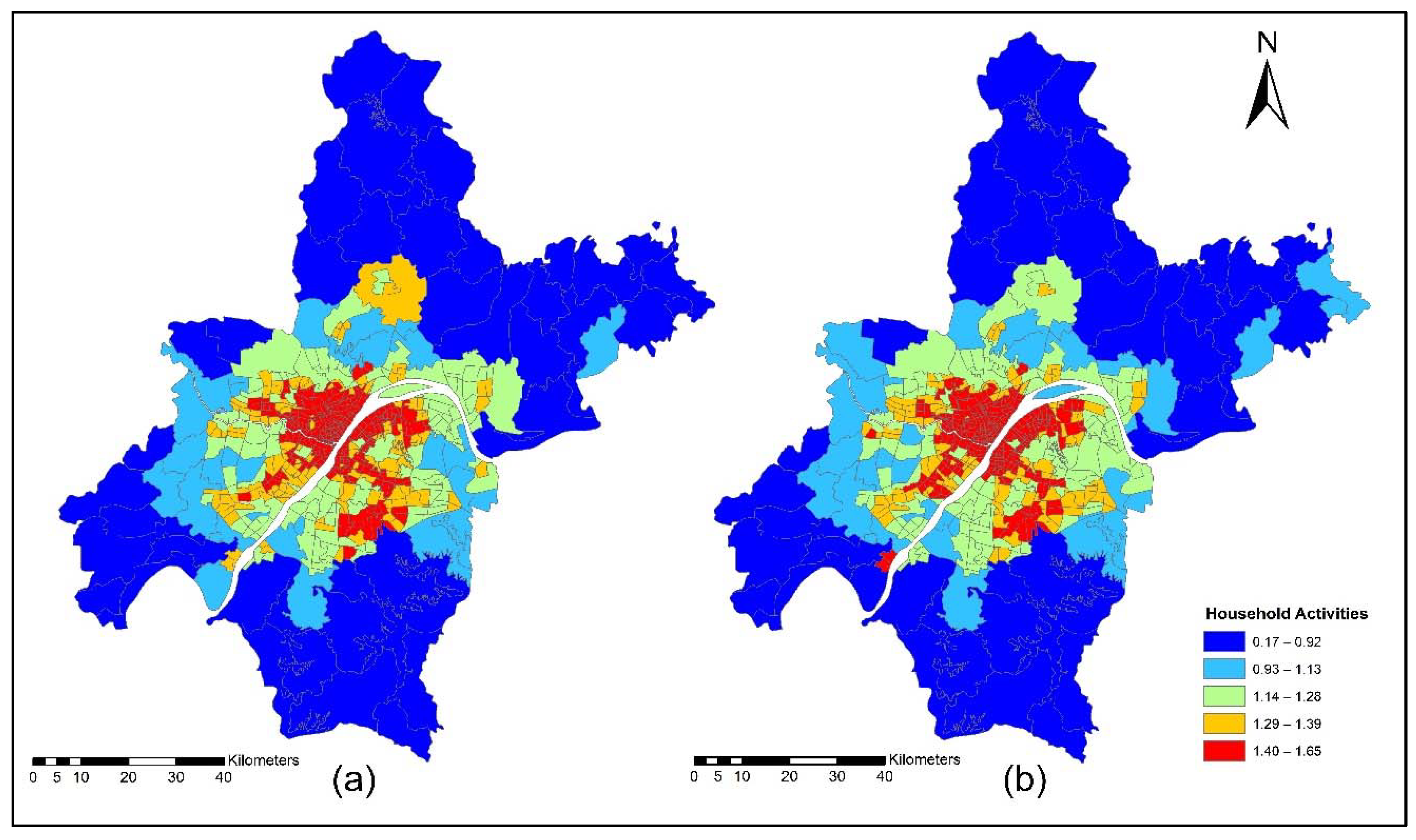
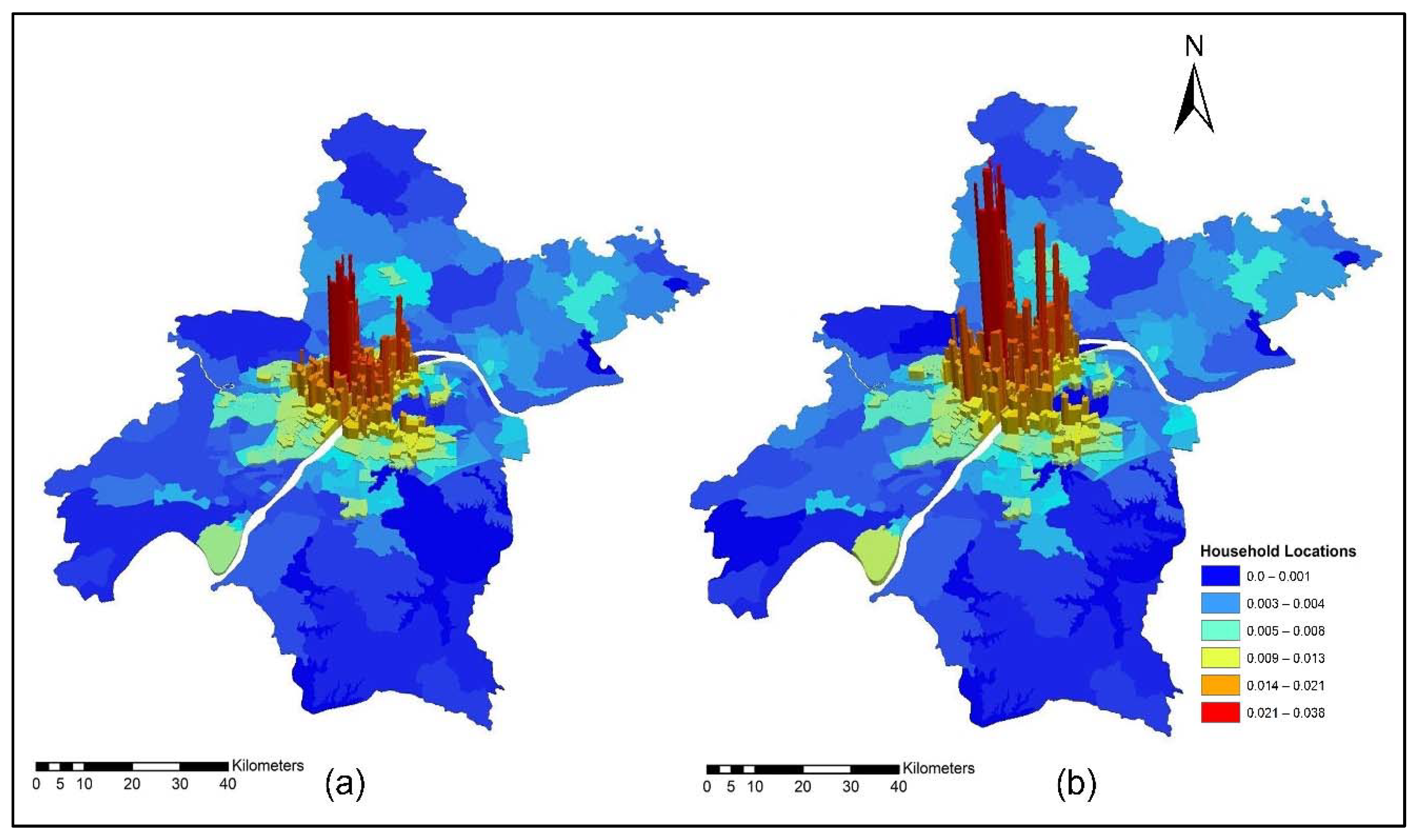

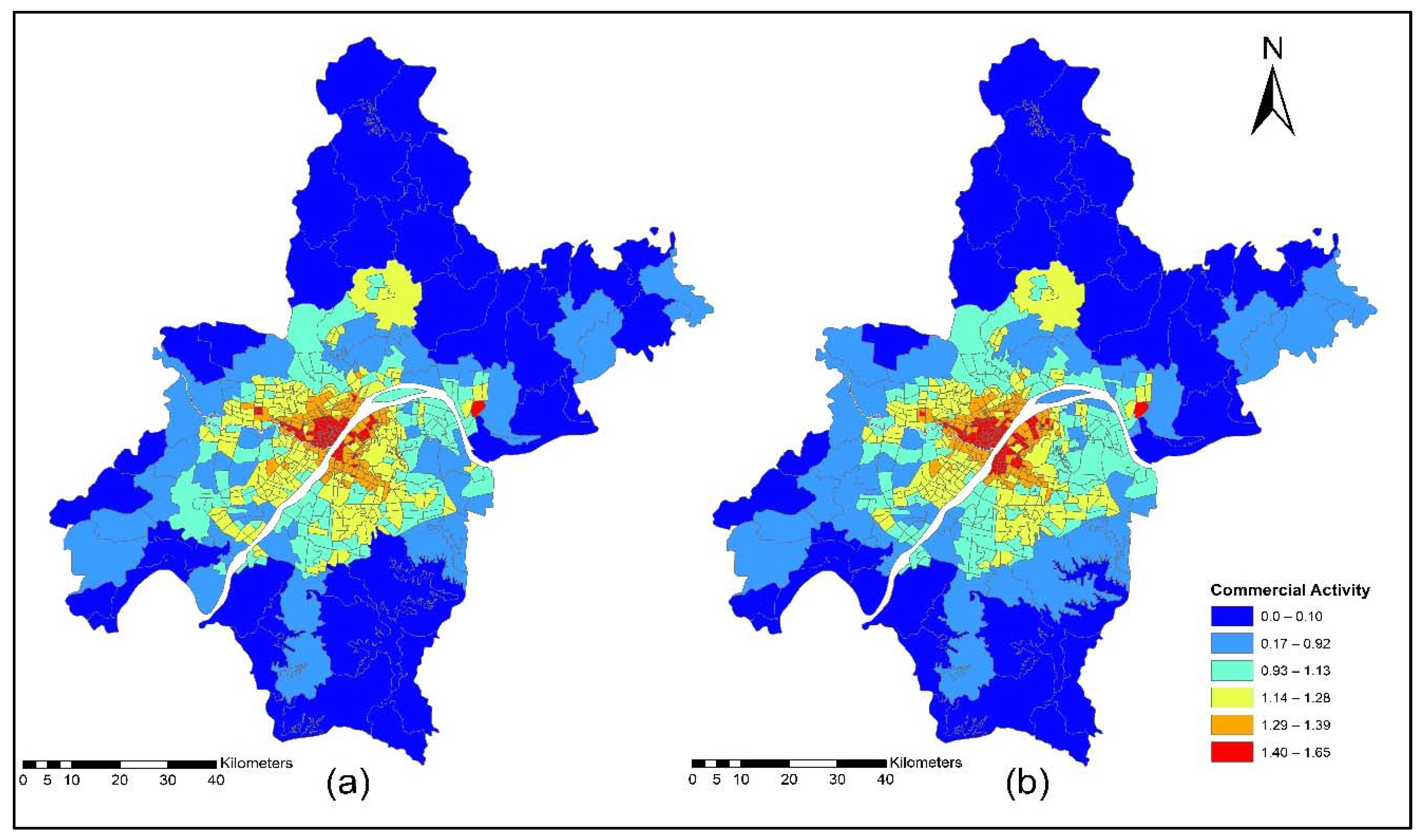


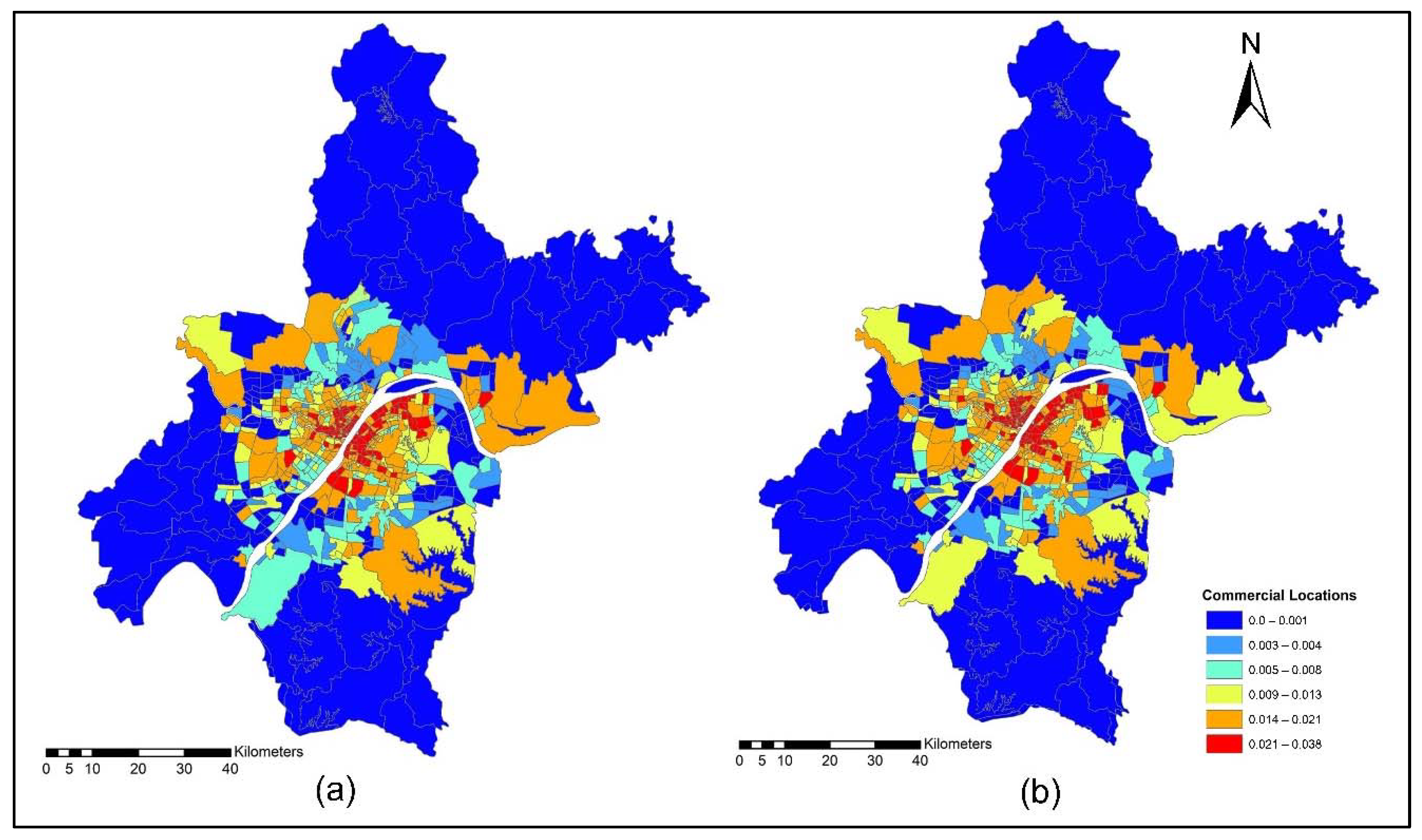
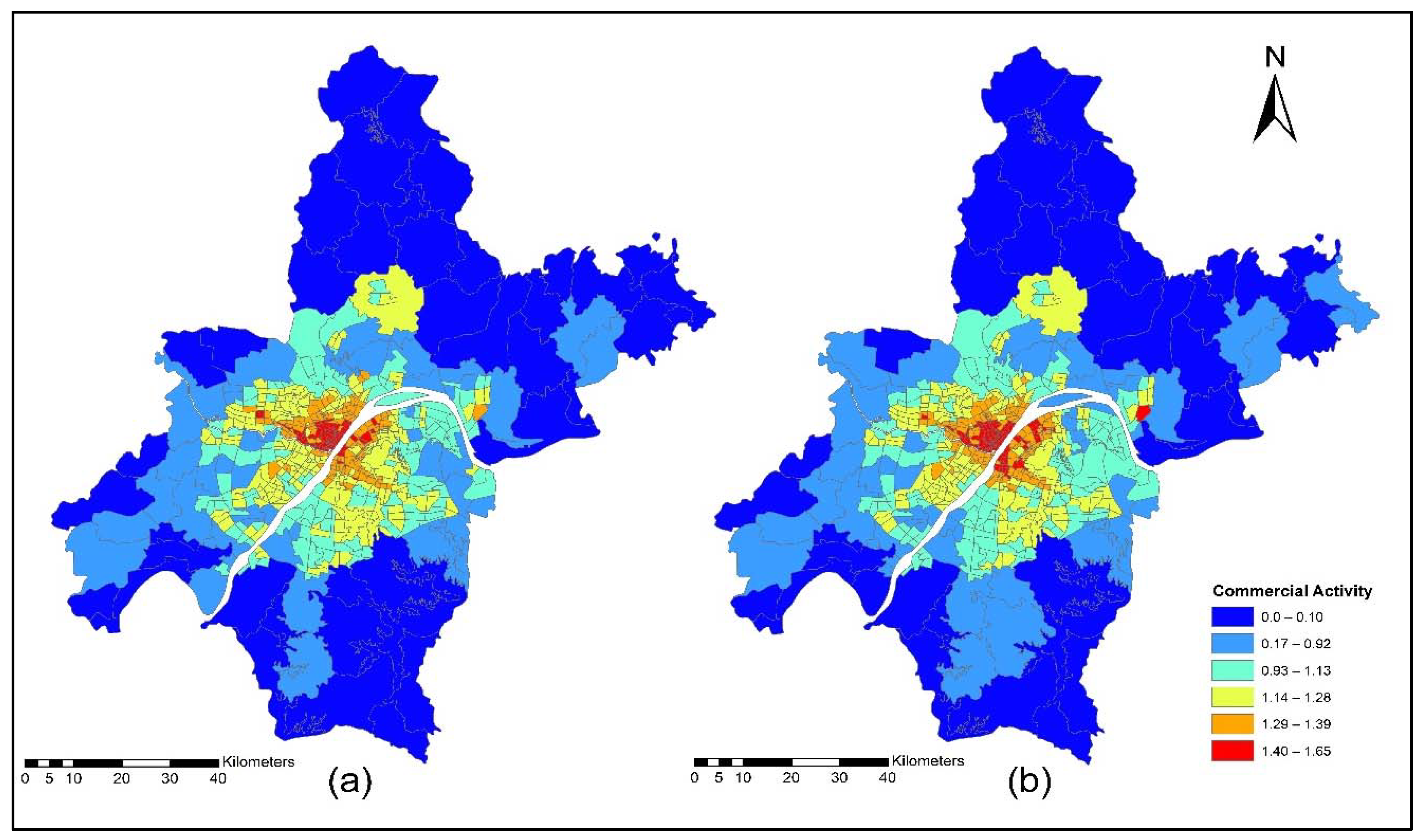
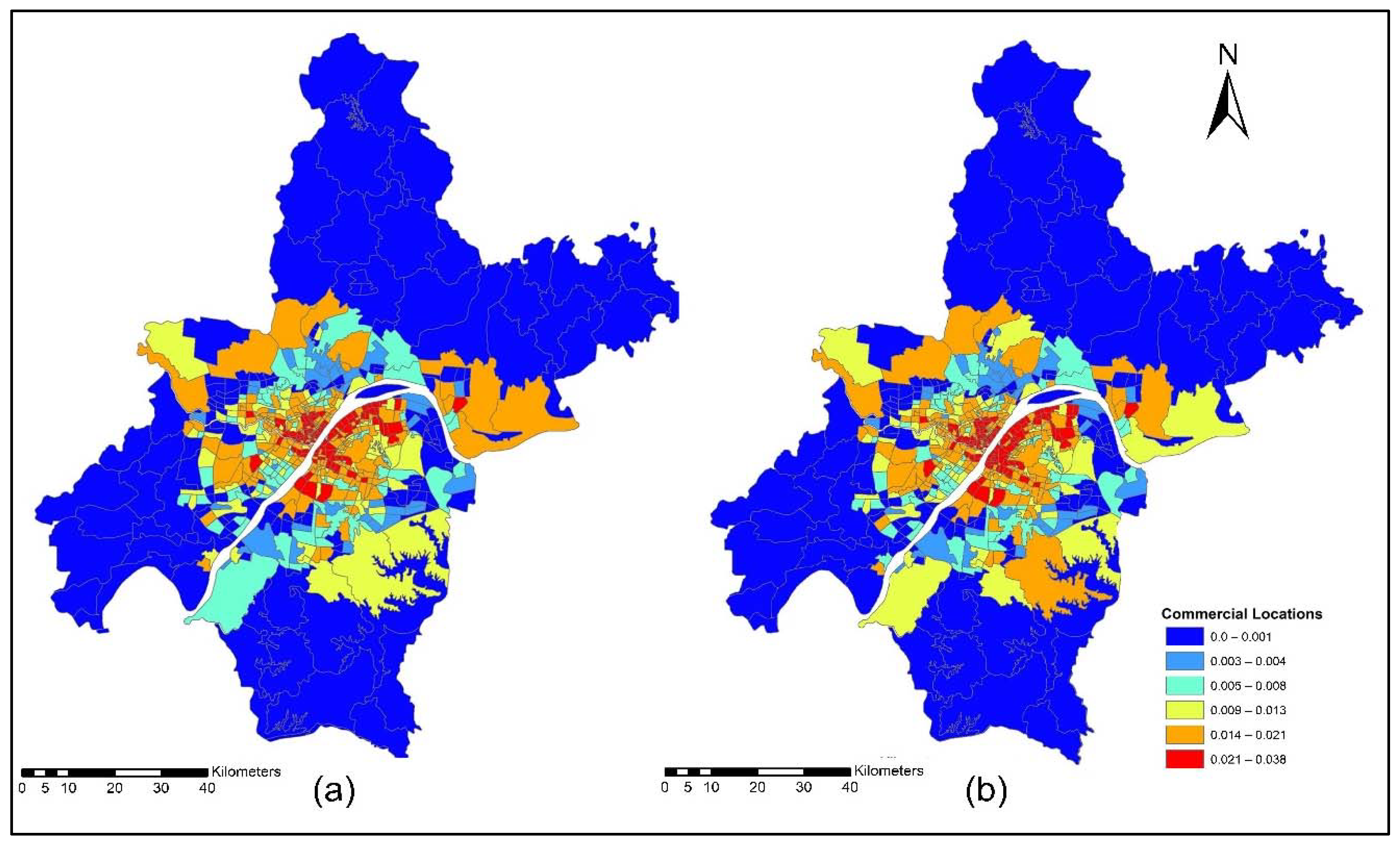
| Road Network | Description |
|---|---|
| Link type | Freeway, expressway, arterial, collector, and local |
| Distance | link distance (Km) |
| Road capacity | Daily and hourly capacity of each link |
| Lanes | Number of lanes in each link |
| AADTs | Average annual daily traffic counts collected at main road corridors |
| Screen lines | Screen line number associated with each AADT (used for model calibration) |
| Speed | Free-flow and congested speed |
| Name | Bus Name/Metro Name | ||
|---|---|---|---|
| Time | Congested Time | ||
| Distance | Distance in km | ||
| Service frequency (minutes) | Modes | Metro | Bus |
| Morning peak | 3 | 3 | |
| Off-peak | 7 | 10 | |
| Evening peak | 5 | 5 | |
| Mode | Metro (Mode 1) | ||
| Bus (Mode 2) | |||
| Line ID | Bus and metro line number | ||
| Fare | Static fare for bus and distance-based for metro | ||
| Waiting time | Initial waiting time and transfer waiting time at bus and metro station | ||
| Other information | Metro | Bus | |
| Walking distance allowed (meters) | 960 | 650 | |
| Transfer distance allowed (meters) | 550 (metro–bus, metro–metro) | 550 (bus–metro, bus–bus) | |
| Activities | |||||
|---|---|---|---|---|---|
| Production | Consumption | ||||
| Morning peak | Off-peak | Evening peak | Morning peak | Off-peak | Evening peak |
| √ | √ | √ | √ | √ | √ |
| Activity Type | Commodity | Labor, Services, and Goods Type | Consume by | Transport Modes | Utility (Disutility) |
|---|---|---|---|---|---|
| Households | Labor | Management and technical labor | Industry and services | Auto, taxi, bus, metro | Logsum |
| Retail service labor | |||||
| Operators labor | |||||
| Commercial services | Services | Commercial services | Households and industry |
| Year | 2012 | 2015 | ||||
|---|---|---|---|---|---|---|
| Time of Day | Morning Peak | Off-Peak | Evening Peak | Morning Peak | Off-Peak | Evening Peak |
| Residual Squares | 5.997 | 7.816 | 7.161 | 5.341 | 6.402 | 6.560 |
| R square | 0.935 | 0.915 | 0.902 | 0.981 | 0.978 | 0.977 |
| Adjusted R square | 0.932 | 0.911 | 0.901 | 0.980 | 0.976 | 0.975 |
| Year | 2012 | 2015 | ||||
|---|---|---|---|---|---|---|
| Time of Day | Morning Peak | Off-Peak | Evening Peak | Morning Peak | Off-Peak | Evening Peak |
| Residual Squares | 69.62 | 68.32 | 70.63 | 9.501 | 8.693 | 9.371 |
| R square | 0.935 | 0.979 | 0.927 | 0.971 | 0.980 | 0.935 |
| Adjusted R square | 0.930 | 0.968 | 0.914 | 0.970 | 0.979 | 0.932 |
| No | Low | Low-Medium | Medium | Medium-High | High | |
|---|---|---|---|---|---|---|
| TDA (logsum) | 0 | 0.22~0.92 | 0.93~1.13 | 1.14~1.28 | 1.29~1.39 | 1.40~1.51 |
| Activity locations (density) | 0 | 0.003~0.004 | 0.005~0.008 | 0.009~0.013 | 0.014~0.021 | 0.022~0.038 |
| Static Model | ISE-TDA Model | |||
|---|---|---|---|---|
| Activities | Time of Day | R-Squared | Time of Day | R-Squared |
| Households | Daily | 0.727 | Morning peak | 0.981 |
| Off-peak | 0.978 | |||
| Evening peak | 0.977 | |||
| Commercial | Daily | 0.485 | Morning peak | 0.971 |
| Off-peak | 0.980 | |||
| Evening peak | 0.935 | |||
Publisher’s Note: MDPI stays neutral with regard to jurisdictional claims in published maps and institutional affiliations. |
© 2022 by the authors. Licensee MDPI, Basel, Switzerland. This article is an open access article distributed under the terms and conditions of the Creative Commons Attribution (CC BY) license (https://creativecommons.org/licenses/by/4.0/).
Share and Cite
Raza, A.; Zhong, M.; Safdar, M. Evaluating Locational Preference of Urban Activities with the Time-Dependent Accessibility Using Integrated Spatial Economic Models. Int. J. Environ. Res. Public Health 2022, 19, 8317. https://doi.org/10.3390/ijerph19148317
Raza A, Zhong M, Safdar M. Evaluating Locational Preference of Urban Activities with the Time-Dependent Accessibility Using Integrated Spatial Economic Models. International Journal of Environmental Research and Public Health. 2022; 19(14):8317. https://doi.org/10.3390/ijerph19148317
Chicago/Turabian StyleRaza, Asif, Ming Zhong, and Muhammad Safdar. 2022. "Evaluating Locational Preference of Urban Activities with the Time-Dependent Accessibility Using Integrated Spatial Economic Models" International Journal of Environmental Research and Public Health 19, no. 14: 8317. https://doi.org/10.3390/ijerph19148317
APA StyleRaza, A., Zhong, M., & Safdar, M. (2022). Evaluating Locational Preference of Urban Activities with the Time-Dependent Accessibility Using Integrated Spatial Economic Models. International Journal of Environmental Research and Public Health, 19(14), 8317. https://doi.org/10.3390/ijerph19148317







